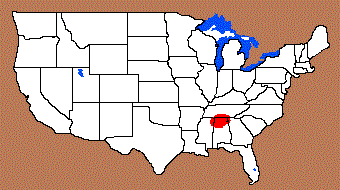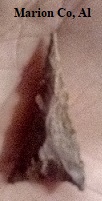Outline is Representative of Size and Shape:

Name Details:
Identified By: James Cambron and David Hulse
Named For:
Date Identified: 1975
Type Site:
Identified By: James Cambron and David Hulse
Named For:
Date Identified: 1975
Type Site:
Point Validity:
Valid type
Cambron is a distinguished avocational archaeologist that did extensive work in Alabama and the Tennessee River valley. Hulse is a renowned avocational archaeologist who did extensive work in Alabama. This point was named in a personally published book. This point has been referred to in numerous professional publications and is considered a valid type.
Cambron is a distinguished avocational archaeologist that did extensive work in Alabama and the Tennessee River valley. Hulse is a renowned avocational archaeologist who did extensive work in Alabama. This point was named in a personally published book. This point has been referred to in numerous professional publications and is considered a valid type.
Sand Mountain Triangle
Cluster: Late Woodland to Early Mississippian Triangle Cluster Description of Physical Characteristics and Flaking Pattern:
This is a small triangular point with an elliptical cross section. The blade may vary from straight to slightly excurvate and is deeply serrated. The base is concave with sharp basal corners. This point has a random flaking pattern.
Size Measurements:
Total Length - 21 to 27 mm (24 mm average), Base Width - 13 to 15 mm (14 mm average), Thickness - 3 to 7 mm, Basal Concavity - 1 to 4 mm (2 mm average)
Total Length - 21 to 27 mm (24 mm average), Base Width - 13 to 15 mm (14 mm average), Thickness - 3 to 7 mm, Basal Concavity - 1 to 4 mm (2 mm average)
Commonly Utilized Material:
Additional Comments:
This type is similar to the Fort Ancient type, but is differentiated by the base. The Fort Ancient type has a straight base and the Sand Mountain type has a concave base.
This type is similar to the Fort Ancient type, but is differentiated by the base. The Fort Ancient type has a straight base and the Sand Mountain type has a concave base.
Distribution:
Distribution Comments:
This point is primarily found in northern Alabama and into Tennessee, Mississippi, and Georgia.
This point is primarily found in northern Alabama and into Tennessee, Mississippi, and Georgia.
Age / Periods:
Date: 1,500 - 800 B.P.
Cultural Period: Late Woodland to Mississippian
Glacial Period: Roman Warm to Medieval Warm
Culture:
Date: 1,500 - 800 B.P.
Cultural Period: Late Woodland to Mississippian
Glacial Period: Roman Warm to Medieval Warm
Culture:
Age Details:
Other points in this cluster / Related / Associated Points:


